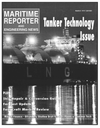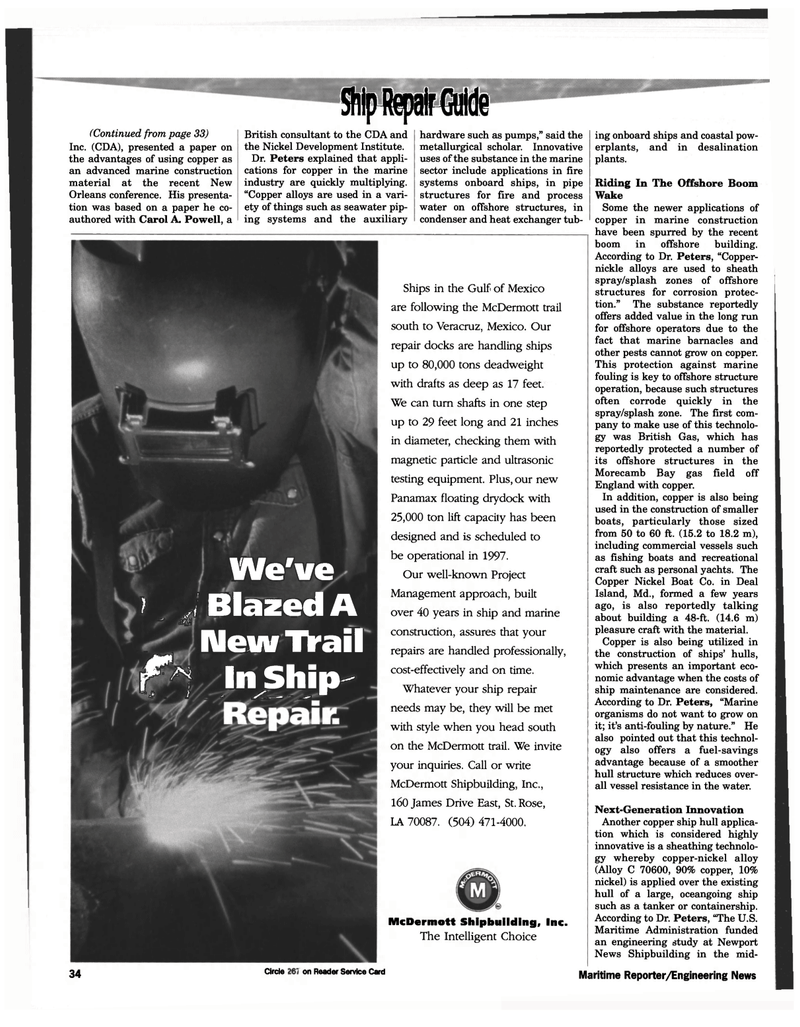
Page 26: of Maritime Reporter Magazine (March 1997)
Read this page in Pdf, Flash or Html5 edition of March 1997 Maritime Reporter Magazine
Ship Repair Guide (Continued from page 33)
Inc. (CDA), presented a paper on the advantages of using copper as an advanced marine construction material at the recent New
Orleans conference. His presenta- tion was based on a paper he co- authored with Carol A. Powell, a
British consultant to the CDA and the Nickel Development Institute.
Dr. Peters explained that appli- cations for copper in the marine industry are quickly multiplying. "Copper alloys are used in a vari- ety of things such as seawater pip- ing systems and the auxiliary hardware such as pumps," said the metallurgical scholar. Innovative uses of the substance in the marine sector include applications in fire systems onboard ships, in pipe structures for fire and process water on offshore structures, in condenser and heat exchanger tub-
Ships in the Gulf of Mexico are following the McDermott trail south to Veracruz, Mexico. Our repair docks are handling ships up to 80,000 tons deadweight with drafts as deep as 17 feet.
We can turn shafts in one step up to 29 feet long and 21 inches in diameter, checking them with magnetic particle and ultrasonic testing equipment. Plus, our new
Panamax floating drydock with 25,000 ton lift capacity has been designed and is scheduled to be operational in 1997.
Our well-known Project
Management approach, built over 40 years in ship and marine construction, assures that your repairs are handled professionally, cost-effectively and on time.
Whatever your ship repair needs may be, they will be met with style when you head south on the McDermott trail. We invite your inquiries. Call or write
McDermott Shipbuilding, Inc., 160 James Drive East, St. Rose,
LA 70087. (504) 471-4000.
McDermott Shipbuilding, Inc.
The Intelligent Choice 34 Circle 333 on Reader Service Card ing onboard ships and coastal pow- erplants, and in desalination plants.
Riding In The Offshore Boom
Wake
Some the newer applications of copper in marine construction have been spurred by the recent boom in offshore building.
According to Dr. Peters, "Copper- nickle alloys are used to sheath spray/splash zones of offshore structures for corrosion protec- tion." The substance reportedly offers added value in the long run for offshore operators due to the fact that marine barnacles and other pests cannot grow on copper.
This protection against marine fouling is key to offshore structure operation, because such structures often corrode quickly in the spray/splash zone. The first com- pany to make use of this technolo- gy was British Gas, which has reportedly protected a number of its offshore structures in the
Morecamb Bay gas field off
England with copper.
In addition, copper is also being used in the construction of smaller boats, particularly those sized from 50 to 60 ft. (15.2 to 18.2 m), including commercial vessels such as fishing boats and recreational craft such as personal yachts. The
Copper Nickel Boat Co. in Deal
Island, Md., formed a few years ago, is also reportedly talking about building a 48-ft. (14.6 m) pleasure craft with the material.
Copper is also being utilized in the construction of ships' hulls, which presents an important eco- nomic advantage when the costs of ship maintenance are considered.
According to Dr. Peters, "Marine organisms do not want to grow on it; it's anti-fouling by nature." He also pointed out that this technol- ogy also offers a fuel-savings advantage because of a smoother hull structure which reduces over- all vessel resistance in the water.
Next-Generation Innovation
Another copper ship hull applica- tion which is considered highly innovative is a sheathing technolo- gy whereby copper-nickel alloy (Alloy C 70600, 90% copper, 10% nickel) is applied over the existing hull of a large, oceangoing ship such as a tanker or containership.
According to Dr. Peters, "The U.S.
Maritime Administration funded an engineering study at Newport
News Shipbuilding in the mid-
Maritime Reporter/Engineering News
We've ' ^ A Blazed A jti lUewTVail 0m In Ship- ' • j . / •

 25
25

 27
27
